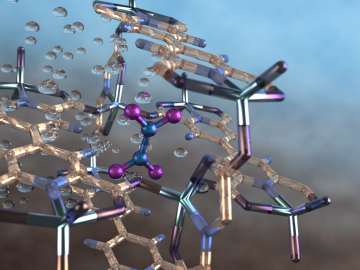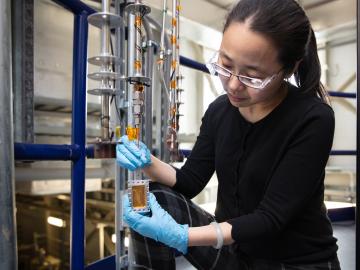
Filter News
Area of Research
- (-) Advanced Manufacturing (1)
- (-) Materials (61)
- (-) National Security (14)
- (-) Neutron Science (24)
- Biological Systems (2)
- Biology and Environment (134)
- Biology and Soft Matter (1)
- Computational Biology (1)
- Computational Engineering (2)
- Computer Science (4)
- Electricity and Smart Grid (1)
- Energy Science (147)
- Energy Sciences (1)
- Functional Materials for Energy (2)
- Fusion and Fission (9)
- Fusion Energy (1)
- Isotopes (2)
- Materials for Computing (6)
- Mathematics (1)
- Nuclear Science and Technology (2)
- Quantum information Science (1)
- Supercomputing (83)
News Topics
- (-) Bioenergy (19)
- (-) Energy Storage (39)
- (-) Environment (26)
- (-) Partnerships (15)
- (-) Simulation (2)
- (-) Summit (7)
- 3-D Printing/Advanced Manufacturing (46)
- Advanced Reactors (6)
- Artificial Intelligence (25)
- Big Data (8)
- Biology (14)
- Biomedical (21)
- Biotechnology (2)
- Buildings (6)
- Chemical Sciences (34)
- Clean Water (4)
- Composites (12)
- Computer Science (40)
- Coronavirus (15)
- Critical Materials (13)
- Cybersecurity (21)
- Exascale Computing (2)
- Fossil Energy (1)
- Frontier (4)
- Fusion (9)
- Grid (11)
- High-Performance Computing (10)
- Hydropower (1)
- Irradiation (1)
- Isotopes (13)
- ITER (1)
- Machine Learning (19)
- Materials (85)
- Materials Science (89)
- Mathematics (1)
- Microscopy (27)
- Molten Salt (3)
- Nanotechnology (43)
- National Security (35)
- Neutron Science (127)
- Nuclear Energy (23)
- Physics (30)
- Polymers (18)
- Quantum Computing (4)
- Quantum Science (16)
- Security (12)
- Space Exploration (6)
- Transportation (21)
Media Contacts

Researchers have developed a new process that could make it much cheaper to produce biofuels such as ethanol from plant waste and reduce reliance on fossil fuels.

To better determine the potential energy cost savings among connected homes, researchers at Oak Ridge National Laboratory developed a computer simulation to more accurately compare energy use on similar weather days.

Illustration of the optimized zeolite catalyst, or NbAlS-1, which enables a highly efficient chemical reaction to create butene, a renewable source of energy, without expending high amounts of energy for the conversion. Credit: Jill Hemman, Oak Ridge National Laboratory/U.S. Dept. of Energy

An international team of scientists, led by the University of Manchester, has developed a metal-organic framework, or MOF, material

Students often participate in internships and receive formal training in their chosen career fields during college, but some pursue professional development opportunities even earlier.

Researchers at the Department of Energy’s Oak Ridge National Laboratory have received five 2019 R&D 100 Awards, increasing the lab’s total to 221 since the award’s inception in 1963.

Two of the researchers who share the Nobel Prize in Chemistry announced Wednesday—John B. Goodenough of the University of Texas at Austin and M. Stanley Whittingham of Binghamton University in New York—have research ties to ORNL.

A team of researchers at Oak Ridge National Laboratory have demonstrated that designed synthetic polymers can serve as a high-performance binding material for next-generation lithium-ion batteries.

Researchers at the Department of Energy’s Oak Ridge National Laboratory, Pacific Northwest National Laboratory and Washington State University teamed up to investigate the complex dynamics of low-water liquids that challenge nuclear waste processing at federal cleanup sites.

Ionic conduction involves the movement of ions from one location to another inside a material. The ions travel through point defects, which are irregularities in the otherwise consistent arrangement of atoms known as the crystal lattice. This sometimes sluggish process can limit the performance and efficiency of fuel cells, batteries, and other energy storage technologies.


